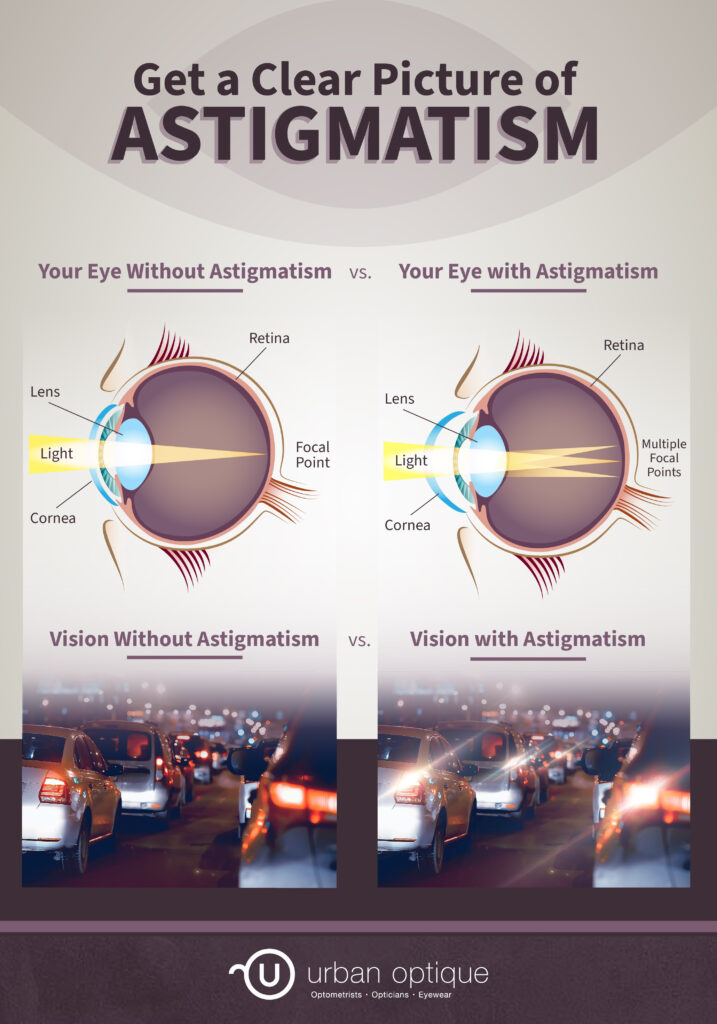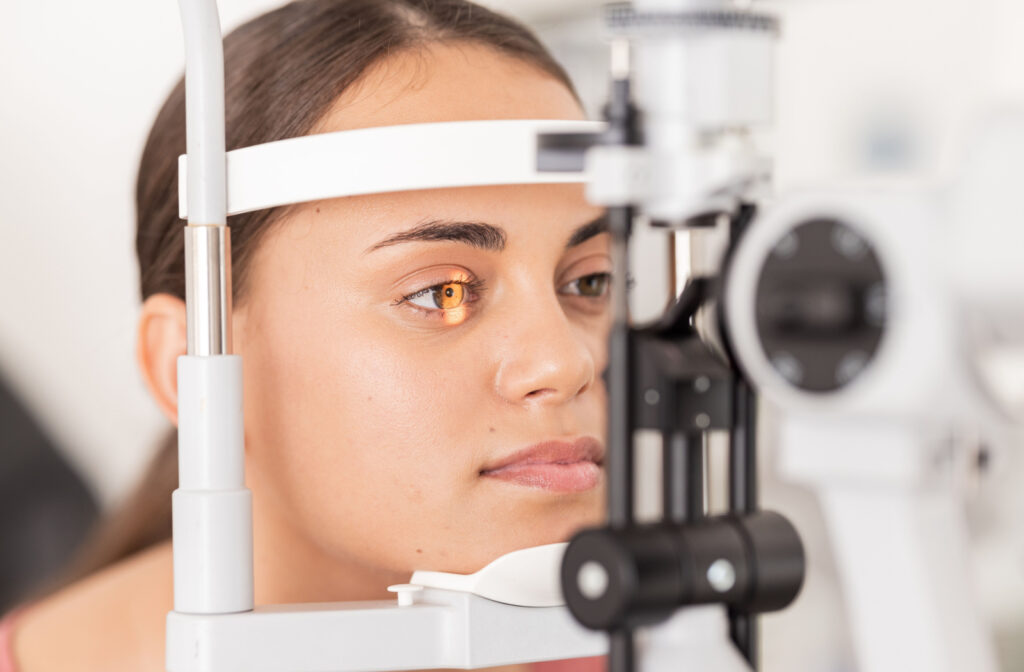No 2 pairs of eyes are exactly alike, and sometimes, when the shape of your eye is different, it can make your vision look different, too. Astigmatism makes your vision blurry at all distances. It occurs when the eye is shaped more like an egg, oval, or football rather than a perfect sphere.
Astigmatism can be diagnosed during a comprehensive eye exam and corrected with glasses, contact lenses, or laser eye surgery.
How Can You Tell If You Have Astigmatism?
It can sometimes be challenging to identify astigmatism without an eye exam or the ability to see through another person’s eyes.
You may only realize you have astigmatism once someone brings attention to your visual difficulties. This can be particularly true for children who may not recognize that their vision is distorted. If you notice someone squinting frequently or complaining about difficulty seeing, it could be a sign of astigmatism.
What Are the Symptoms of Astigmatism?
4 common refractive errors cause blurry vision:
- Myopia, or nearsightedness, causes blurry distance vision with near vision remaining clear.
- Hyperopia, or farsightedness, causes blurry near vision with distance vision remaining clear.
- Presbyopia causes blurry near vision as the eyes age.
- Astigmatism causes blurry vision at all distances.
Astigmatism is unique because it is the only refractive error that affects both distance and near vision. It usually occurs due to an irregularly shaped cornea that causes light to be focused on 2 different points instead of one.
Aside from blurry vision, astigmatism can also cause:
- Streaks, glares, or halos around lights
- Frequent squinting
- Headaches
- Eye strain
Do People with Astigmatism See Differently?
Some people with astigmatism might notice specific visual distortions when looking at light, particularly at night or in low-light environments. Some people with astigmatism report seeing streaks or halos around lights that can make it challenging to drive at night.
How Is Astigmatism Connected to the Shape of the Eyes?
Astigmatism is a refractive error, which is caused by changes in your eye’s ability to focus light correctly. As light passes through your cornea (the front part of your eye), it’s focused by your lens onto your retina. Changes in the shape of your cornea or lens can cause light to miss your retina or only hit part of it, resulting in blurry vision.
When you have astigmatism, your cornea or lens takes on an ovular shape, like a football, causing light to miss your retina. Astigmatism caused by your cornea’s shape is called corneal astigmatism, while astigmatism caused by your lens is called lenticular astigmatism.

What Causes Astigmatism?
Astigmatism can be present from birth, or it can develop over time. Because it’s generally considered a genetic eye condition, you may be more likely to develop astigmatism if you have a family history of astigmatism—particularly if either of your biological parents has astigmatism.
In addition to genetic factors, astigmatism may also be caused by:
- Eye injuries
- Keratoconus
- Complications related to eye surgery
If you experience sudden changes to your vision, it’s important to speak with an eye doctor. Many eye diseases and conditions develop gradually, and by the time they cause changes to your vision, their effects may be permanent.
Astigmatism shares some of its symptoms with other serious eye diseases. Getting precise diagnosis and early treatment is crucial for protecting your vision.
Can Astigmatism Be Corrected?
In many cases, those with astigmatism can use prescription glasses and contact lenses to see clearly. During an eye or contact lens exam, we’ll take measurements to determine the degree of astigmatism affecting your vision and provide a prescription based on your eyesight.
Sometimes, LASIK and other laser vision correction procedures may be an option. However, the results of laser eye surgery can vary based on the severity of your astigmatism, so LASIK may not be recommended.
How Do You Stop Astigmatism from Getting Worse?
There are currently no known methods for preventing astigmatism or stopping it from getting worse. Fortunately, if your astigmatism does change over time, your prescription can be adjusted to continue providing clear vision.
When your eyes are affected by astigmatism, it’s important to visit your eye doctor for regular eye exams. We can help monitor your vision and adjust your prescription as needed.
Can Vision Therapy Help with Astigmatism?
Vision therapy can help address some of the symptoms of astigmatism, but it can’t correct blurry vision or other vision problems caused by astigmatism. Vision therapy exercises for astigmatism usually focus on reducing eye strain and improving your eyes’ ability to work together effectively when one or both eyes are affected by astigmatism.

When Should You Talk to an Eye Doctor About Astigmatism?
If you or someone you know is struggling with visual challenges, talking to an eye doctor is critical. At Urban Optique, we’re ready to help you determine what’s affecting your vision. The sooner you schedule an eye exam, the sooner we can provide a diagnosis and support for your eye health and vision needs. Schedule your appointment today to talk to us about your vision needs. We are passionate about answering your questions and providing a comprehensive, thorough eye care experience.
















